 Does your company use hashtag campaigns?
Does your company use hashtag campaigns?
Would you like to get the most out of your hashtag campaigns?
In this article you will discover how Travelocity successfully implemented the most successful social campaign in the company's history.
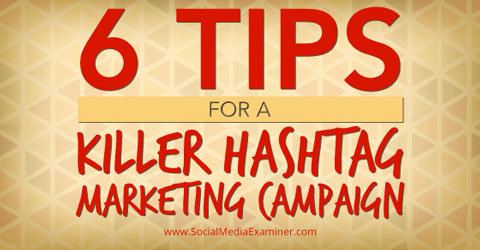
Social Media Handles & Stats
Company: Travelocity
Facebook – 293,110 followers
Twitter – 143,000 followers, @RoamingGnome – 80,883 followers
Instagram – 6,904 followers
Google+ – 2,487,020 followers
YouTube – 2,812 subscribers
Highlights
Get World-Class Marketing Training — All Year Long!
Are you facing doubt, uncertainty, or overwhelm? The Social Media Marketing Society can help.
Each month, you’ll receive training from trusted marketing experts, covering everything from AI to organic social marketing. When you join, you’ll also get immediate access to:
- A library of 100+ marketing trainings
- A community of like-minded marketers
- Monthly online community meetups
- Relevant news and trends updates
- Social impressions during the 3 months of the #IWannaGo campaign in 2014 increased 23% over those from the entire 2013 year, and Twitter engagement increased 4 times over their previous highest average.
- 95% of visitors to the #IWannaGo landing page scrolled below the “loading” level to view more posts.
- Travelocity led competitors by an average of 5% in unaided brand awareness during the #IWannaGo campaign.
- Travelocity increased purchase consideration 11% for key consumers during the first half of the #IWannaGo campaign.
For the follow-up to their 2013 campaign, “Go and Smell the Roses,” Travelocity wanted to match the number of social impressions from 2013. That doesn't sound like much of a stretch, except that they wanted to accomplish it in only three months.
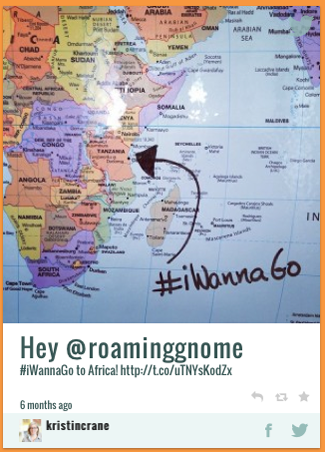
The #IWannaGo campaign ran from early March to early May 2014. Two grand prize trips were given away, one in April and one in June. The campaign was so successful, Travelocity not only matched the social impressions from 2013 in three months, they exceeded them by 23%, from 158 million to 200 million. They also increased their Twitter following on @RoamingGnome by 118%.
Here's what Travelocity did to make this campaign so successful.
#1: Find Out What Your Audience Is Already Talking About
In planning for 2014 marketing, Travelocity wanted to follow up their “Go and Smell the Roses” idea to include two-way communication with their audience. “We're telling them to go and smell the roses,” said director of brand marketing Brett Steiger. “Let's find out where they want to go and help them get there if we can.”
They realized during the previous campaign that followers were interested in engaging with their mascot, the Roaming Gnome. So they decided with #IWannaGo to have followers tell him directly where their dream destination was.
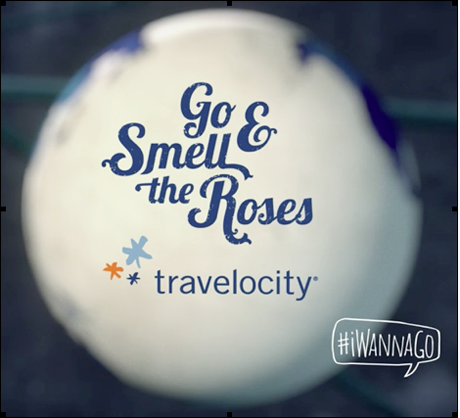
#2: Use Appropriate Channels and a Low Barrier to Entry
All participants needed to do to enter the #IWannaGo campaign was to follow @RoamingGnome on Twitter or Instagram, and post to either platform with their dream travel destination, including the #IWannaGo hashtag. Then they would be entered into the drawing to receive one of two grand prizes of a weeklong trip to their destination.
Travelocity used only Twitter and Instagram for the contest entries because that is where the Roaming Gnome “lives” the most. “The Roaming Gnome is very much a person, a character,” said Steiger. “And like a lot of travelers, [Twitter and Instagram] are the key ways [he] engages on social media.”
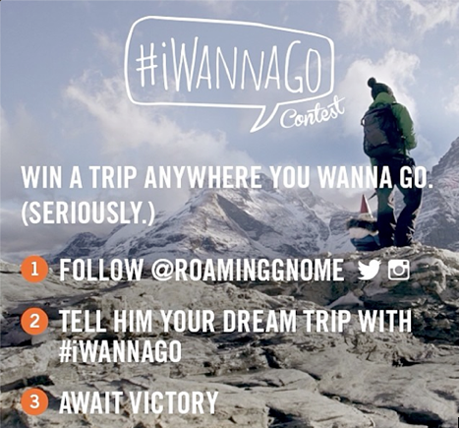
Contestants did not need to go to a separate website or fill out any forms. They were not required to include any photos or videos, although they were encouraged to do so if they wished. Steiger explained that they wanted to have as low a barrier to entry as possible.
Participants did not have to go to the campaign landing page, but if they did, they found content that was more engaging than simply a link to the contest rules. Travelocity used Tint to turn the landing page into a social hub with all of the #IWannaGo posts from Twitter and Instagram.

Discover Proven Marketing Strategies and Tips
Want to go even deeper with your marketing? Check out the Social Media Marketing Podcast! Publishing weekly since 2012, the Social Media Marketing Podcast helps you navigate the constantly changing marketing jungle, with expert interviews from marketing pros.
But don’t let the name fool you. This show is about a lot more than just social media marketing. With over 600 episodes and millions of downloads each year, this show has been a trusted source for marketers for well over a decade.
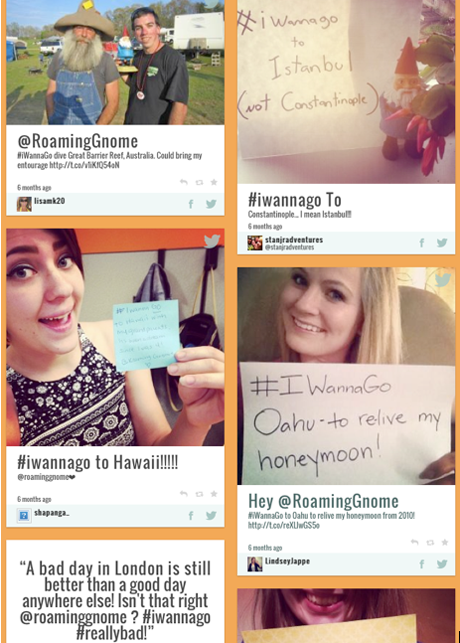
#3: Be Genuine
Turning the campaign landing page into a social hub is just one example of how Travelocity used opportunities to be genuine with their followers. “We wanted a place where we could aggregate a lot of the other entries to really inspire other consumers to participate as well,” said Steiger.
It worked. The landing page itself received over 32 million impressions, and 95% of visitors scrolled below the “loading” level of the page to see more content.
“The more we can talk with consumers about things that they care about … versus always forcing something a little too branded, we found that we get we get better engagement, better conversations and less attrition from our consumers,” said Steiger.
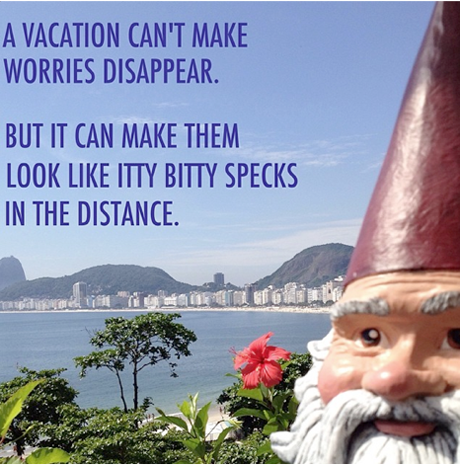
Keith Nowak, Travelocity director of communications and brand integration, added that having a topic that people care about passionately such as travel could be a double-edged sword. “It gives us the opportunity to engage with something that people are naturally excited about, but you'd better be authentic and on-point when talking about it,” he said.
#4: Partner With Traditional Media
Travelocity has a 10-year relationship with the television show The Amazing Race. This longtime association gave them a great existing platform to kick off the #IWannaGo campaign. “TV is still extremely powerful to generate larger brand awareness of any type of contest or program or new product,” said Steiger.
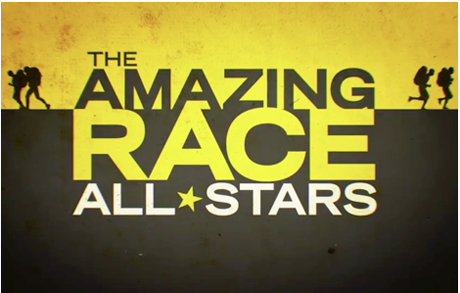
Steiger was quick to add, however, that while TV provided a great launching platform for the campaign, “If we didn't actually have something that was engaging to consumers, it would have jumpstarted and then finished very quickly.”
#5: Be Strategic With Paid Promotion
In addition to paying for exposure on TV, Travelocity also bought the rights to promote the #IWannaGo hashtag on Twitter for a day. “That was big,” said Steiger, “Because then you have 70, 80 million people that may see that on any given day.”
Travelocity did not buy the hashtag on Twitter the first day of the campaign launch. They used their Amazing Race tie-in to kickstart interest, and in the first two days of the campaign after that, #IWannaGo trended organically on Twitter. The third day they used the promoted hashtag to “add more fuel to the fire,” as Steiger put it.
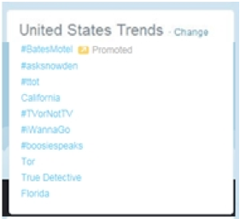
#6: Look for Creative Real-time Marketing Opportunities
To keep the campaign fresh, Travelocity looked for ways to engage in real-time marketing with consumers. One of the ways they did this was using Vine videos. On April 14th, about two-thirds of the way through the entry period, Travelocity encouraged followers to tweet, and let them know that they might get a Vine response.
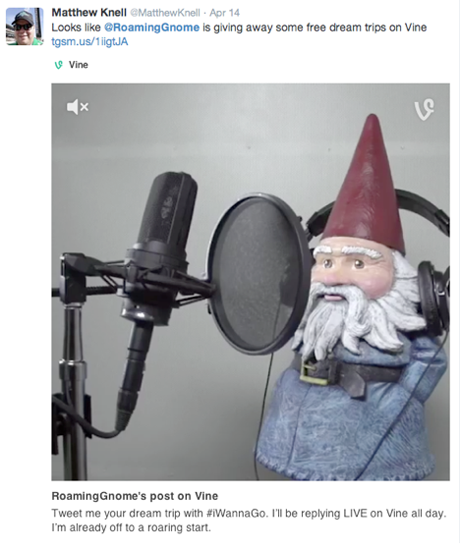
Then they created over 60 Vine videos in response, each within 20-30 minutes of when they were submitted.
“It was a way to show consumers that it's not just a computer back here that's typing for itself. The gnome and his entourage are listening to you and paying attention and wanting to get back to you—not in two days, not in a week, but 20 or 30 minutes,” said Steiger.
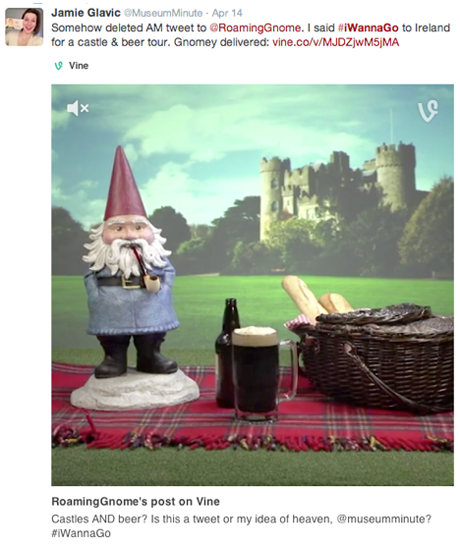
Even though they know he's not real, people are “totally psyched” when they get a Vine or a tweet from the gnome, he added.
It's all about the results.
The success of any campaign is measured by its results. In addition to measuring social metrics such as impressions and engagement, Travelocity uses YouGov research to track brand metrics. According to YouGov, during the first month and a half of the campaign, Travelocity increased purchase consideration by 11% for key consumers.
This means consumers said yes when asked if they would consider Travelocity if they were looking into booking travel. They also led competitors in unaided brand awareness by 5% during the campaign; for example, when survey participants were asked what travel companies they thought of, Travelocity was mentioned first.
Many factors contributed to this success, but Steiger says it boils down to one simple concept: “Letting the consumer's voice be the main piece, and letting our consumers inspire other consumers,” he said.
What do you think? How can you create a killer hashtag campaign for your company? Include your comments and questions below.
Attention Agency Owners, Brand Marketers, and Consultants

Introducing the Marketing Agency Show–our newest podcast designed to explore the struggles of agency marketers.
Join show host and agency owner, Brooke Sellas, as she interviews agency marketers and digs deep into their biggest challenges. Explore topics like navigating rough economic times, leveraging AI, service diversification, client acquisition, and much more.
Just pull up your favorite podcast app, search for Marketing Agency Show and start listening. Or click the button below for more information.

